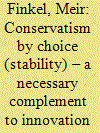| Srl | Item |
| 1 |
ID:
170250


|
|
|
|
|
| Summary/Abstract |
Military innovation and adaptation are regarded as essential attributes of modern military organizations, while conservatism is condemned. Here I define and exemplify a new kind of conservatism – by choice, according to which military organizations deliberately choose not to change. The argument is twofold. First, a combination of conservatism by choice, innovation, and adaptation will lead to a more balanced and agile force than the current trend that over-emphasizes innovation. Second, conservatism by choice of professional military education, unit organization, and command philosophy will enable better utilization of innovations in the fields of weapon systems and tactical doctrine.
|
|
|
|
|
|
|
|
|
|
|
|
|
|
|
|
| 2 |
ID:
144128


|
|
|
|
|
| Summary/Abstract |
The Defence Review 2014 is informed by South Africa's international obligations and inescapable continental leadership responsibilities, such as the combating of maritime crime and piracy. It posits a level of defence ambition based on powerful deterrence, the ability to ‘reach and intervene’ to combat threats to democracy on the continent and an enduring maritime presence to defend and protect South Africa's borders and maritime interests. South Africa's degraded defence capability must furthermore be strengthened over 20 years with defence spending being gradually raised to 2.0%. The suite of naval capabilities will include maritime patrol, autonomous surface warfare, submarine warfare and a ‘blue-navy’ combat support capability to provide enduring presence. Strategic lift becomes essential for the projection and sustainment of forces on the continent.
|
|
|
|
|
|
|
|
|
|
|
|
|
|
|
|
| 3 |
ID:
159190


|
|
|
|
|
| Summary/Abstract |
The 2015 South African Defence Review set out to reverse the deterioration of South African National Defence Force (SANDF) capabilities. Within the South African Department of Defence (DOD) this deterioration is expressed mainly in terms of a decreasing defence budget, subsequent declining conventional capabilities and obsolete prime mission equipment. Contemporary research and defence expert debates on this theme, point out the disjuncture between policy ends and the available means, with scepticism for an increased defence budget given the DOD’s lack of internal reform and strategy adjustment. One question that remains largely unanswered in the literature regarding the decline of the SANDF, is why both the policy-makers and the SANDF have remained focused on the primary role of the military (defending territorial integrity) accompanied with an unaffordable conventional force design? This question relates to the aim of this paper and is explored by revisiting initial defence policy decisions and compromises that were made in the 1990s. It is argued that the primary role of the SANDF and its conventional force design suited the interests of both the politicians and the military, but that the drawbacks thereof have harshly caught up with the DOD.
|
|
|
|
|
|
|
|
|
|
|
|
|
|
|
|